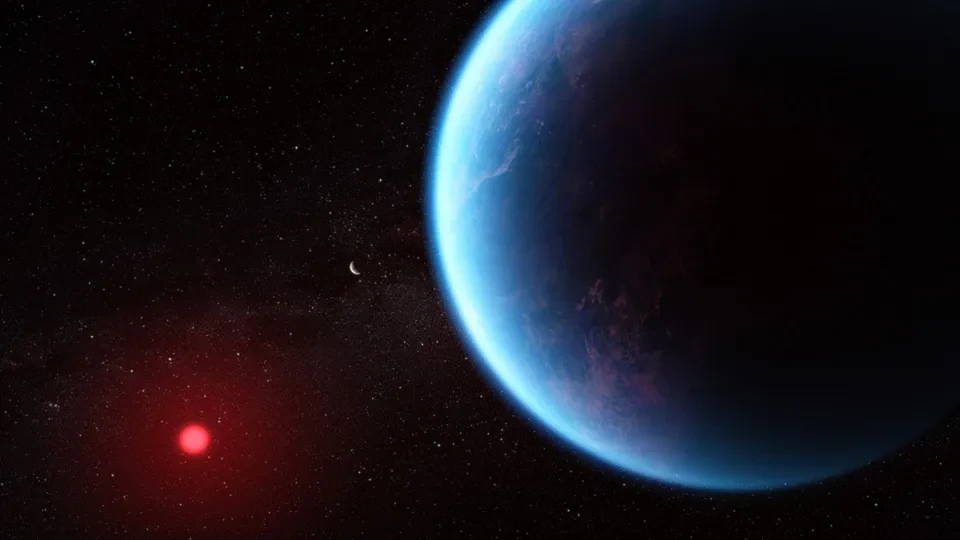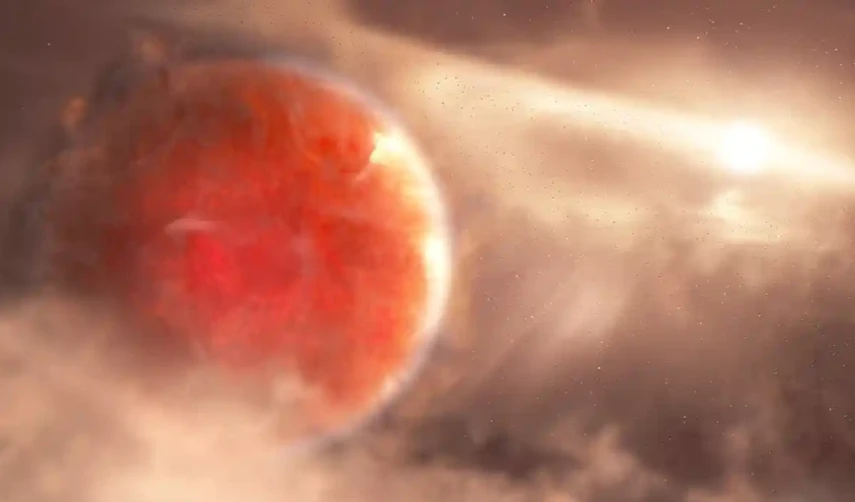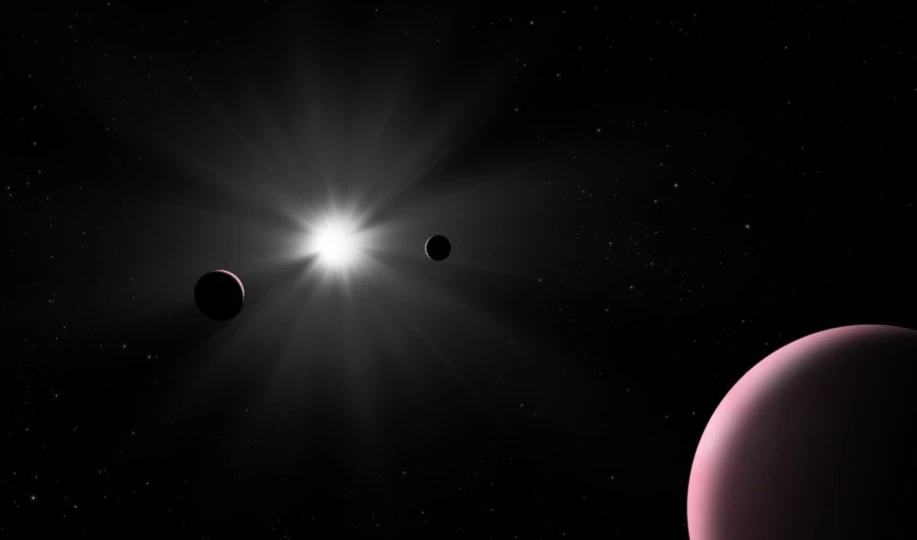Webb Telescope detects possible signs of life beyond solar system
The James Webb Space Telescope detects potential biosignatures on exoplanet K2-18 b, hinting at the strongest signs yet of possible life on an alien planet.
-
 This artist’s concept shows what exoplanet K2-18 b could look like. Illustration: NASA, CSA, ESA, J. Olmsted (STScI), Science: N. Madhusudhan (Cambridge University)
This artist’s concept shows what exoplanet K2-18 b could look like. Illustration: NASA, CSA, ESA, J. Olmsted (STScI), Science: N. Madhusudhan (Cambridge University)
In what may become a groundbreaking moment in the search for extraterrestrial life, researchers using NASA’s James Webb Space Telescope have observed what they believe to be the strongest signs yet of possible life beyond our solar system. Their findings reveal chemical traces in the atmosphere of a distant exoplanet that, on Earth, are only produced by living organisms.
The planet in question, K2-18 b, showed signs of dimethyl sulfide (DMS) and dimethyl disulfide (DMDS), gases that are released primarily by microbial life like marine algae on Earth.
While these findings hint that microbial life could exist in K2-18 b’s environment, scientists emphasize that they haven’t discovered actual organisms. Rather, they’ve detected a possible biosignature, an indirect indication of biological activity, and caution is still warranted as further data are needed.
Still, the discovery has excited the scientific community. Astrophysicist Nikku Madhusudhan of the University of Cambridge, who led the research published in the Astrophysical Journal Letters, said these are the first hints of an alien world that is possibly inhabited.
Are we alone in the universe? Astronomers from @Cambridge_Astro may be a step closer to finding out.
— Cambridge University (@Cambridge_Uni) April 17, 2025
Using data from @ESA_Webb, they’ve detected possible signs of life on exoplanet K2-18b – but they remain cautious.
Read more 👇https://t.co/SsV8KixqQP pic.twitter.com/IkVFqFGCjn
"This is a transformational moment in the search for life beyond the solar system, where we have demonstrated that it is possible to detect biosignatures in potentially habitable planets with current facilities. We have entered the era of observational astrobiology," Madhusudhan said.
He also noted that ongoing studies are exploring possible life within our own solar system, in places such as Mars, Venus, and several icy moons, but emphasized that the discovery around K2-18 b represents a new level of promise.
K2-18 b is a so-called “sub-Neptune” planet, around 8.6 times the mass of Earth and about 2.6 times its diameter. It orbits a red dwarf star in the constellation Leo, approximately 124 light-years away. Importantly, the planet lies within its star’s "habitable zone", meaning that it is at a distance where liquid water could potentially exist on the surface, a critical ingredient for life as we know it.
A potential 'hycean world'
Since the 1990s, astronomers have discovered more than 5,800 exoplanets, including a class known as "hycean worlds". These are planets with hydrogen-rich atmospheres and global oceans that could support microbial life.
Previous data from the Webb telescope already confirmed the presence of methane and carbon dioxide in K2-18 b’s atmosphere. This was the first time that organic, carbon-based compounds were identified on a planet in the habitable zone of another star.
The Webb telescope has detected carbon dioxide and methane in the atmosphere of exoplanet K2-18 b, a potentially habitable world over 8 times bigger than Earth. Webb’s data suggests the planet might be covered in ocean, with a hydrogen-rich atmosphere: https://t.co/qN1SqCfFt1 pic.twitter.com/yoXF3flsUl
— NASA Webb Telescope (@NASAWebb) September 11, 2023
"The only scenario that currently explains all the data obtained so far from JWST (James Webb Space Telescope), including the past and present observations, is one where K2-18 b is a hycean world teeming with life," Madhusudhan said. "However, we need to be open and continue exploring other scenarios."
Madhusudhan clarified the kind of life they’re discussing, saying, "We are talking about microbial life, possibly like what we see in the Earth's oceans." As for more complex life, he added, "we won't be able to answer this question at this stage. The baseline assumption is of simple microbial life."
DMS and DMDS have long been considered strong biosignatures by astrobiologists. The recent Webb observations detected one or both gases at a confidence level of 99.7%, meaning that there’s still a slim chance (about 0.3%) that the data are a fluke. Concentrations were recorded at over 10 parts per million, a level thousands of times greater than what’s found in Earth’s atmosphere.
"For reference, this is thousands of times higher than their concentrations in the Earth's atmosphere, and cannot be explained without biological activity based on existing knowledge," Madhusudhan said.
How the discovery was made
The Webb telescope used the transit method to analyze the planet’s atmosphere. As K2-18 b passed in front of its host star from Earth's perspective, a fraction of the starlight filtered through the planet’s atmosphere and reached the telescope. By studying this light, researchers could infer the chemical makeup of the gases present.
Earlier hints of DMS were seen using Webb, but these new findings were made using different instruments and light wavelengths, lending added weight to the observations.
Madhusudhan called the search for extraterrestrial life “the Holy Grail” of exoplanet science. He noted that humanity has long asked, "are we alone" in the cosmos, and that we may now be on the verge of an answer.
But even with that optimism, he emphasized the importance of rigorous follow-up.
"First we need to repeat the observations two to three times to make sure the signal we are seeing is robust and to increase the detection significance" to the level at which the odds of a statistical fluke are below roughly one in a million, Madhusudhan said.
"Second, we need more theoretical and experimental studies to make sure whether or not there is another abiotic mechanism (one not involving biological processes) to make DMS or DMDS in a planetary atmosphere like that of K2-18 b. Even though previous studies have suggested them (as) robust biosignatures even for K2-18 b, we need to remain open and pursue other possibilities," Madhusudhan said.
He concluded with a note of scientific humility to the scientific discovery: the findings still represent "a big if" when it comes to proving the presence of life. "It is in no one's interest to claim prematurely that we have detected life," Madhusudhan said.

 6 Min Read
6 Min Read










